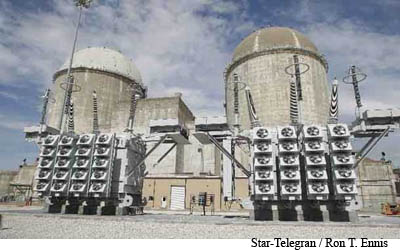Comanche Peak expansion thrown into doubt
December 09, 2010
By Maria Recio
mrecio(at)mcclatchydc.com
Fort Worth Star-Telegram
WASHINGTON — The planned $15 billion expansion of the Comanche Peak nuclear power plant — billed by the plant’s owners as potentially the biggest economic development project ever in Texas — suffered a critical funding setback in Congress this week.
 According to outgoing Rep. Chet Edwards, D-Waco, cuts in the House-passed version of the federal spending bill eliminate loan guarantees that Dallas-based Luminant said were vital to the plan’s viability.
According to outgoing Rep. Chet Edwards, D-Waco, cuts in the House-passed version of the federal spending bill eliminate loan guarantees that Dallas-based Luminant said were vital to the plan’s viability.
Luminant officials say they will continue to push for funding, and Edwards said he hopes the loan guarantees will be approved in the next session of Congress that convenes in January.
But Republicans who pledge even more budget-cutting will take control of the House then, and most observers expect that efforts to increase spending on such things as nuclear plant expansions will face even greater obstacles.
Things had been looking up earlier this year for the proposed expansion of the plant near Glen Rose, about 45 miles southwest of Fort Worth, after President Barack Obama pushed to triple the amount of loan guarantees from the $18.5 billion that had been previously authorized to $54.5 billion. Four plants had been named top choices to receive guarantees from the initial funding, but Comanche Peak missed the cut.
Edwards, who lost his seat to Republican Bill Flores last month, succeeded at the committee level in getting an additional $25 billion in guarantees, which many observers believed would have been enough to cover the Glen Rose expansion.
But the full House, under intense public pressure to slash spending, this week cut the level back to $7 billion in the catch-all government spending bill known as a continuing resolution — an amount that Edwards believes will not take care of Comanche Peak.
The U.S. Senate will vote on the spending bill next week, and it is not clear whether lawmakers who support the loan guarantee program, like Sen. Kay Bailey Hutchison, R-Texas, can do anything to boost the funding before Congress adjourns before Christmas.
Comanche Peak may not receive any loan guarantees under the reduced funding level because it is far down on the priority list set by the Energy Department, Edwards said. Projects in Georgia, Maryland and another Texas facility — NRG’s South Texas Project in Bay City — rank higher, and there may now be only enough money to fund the projects ahead of it.
Edwards said in a statement that losing the election to Flores meant that "I lost my leverage to protect the full $25 billion." Nonetheless, he said he hopes the funding will be approved by the next Congress "because Texas and our nation need nuclear power and the thousands of jobs that come with it."
Luminant officials say they’re not giving up, and spokeswoman Ashley Monts said that even the small increase still on the table in Congress "is an important step in the nation’s nuclear development plans."
"This is a long-term investment opportunity, and we expect that the loan guarantee dialogue will continue to evolve and expand," she said.
Critics of the expansion are pleased.
"They have not been among the front-runners for federal loan guarantees, and that makes it much harder for Comanche Peak to go forward," said Karen Hadden, director of the Austin-based Sustainable Energy and Economic Development Coalition.
Luminant is seeking federal approval for a combined construction and operating license, plus the federal loan guarantees considered crucial to secure financing. The company estimates that the expansion would create 5,000 jobs during five years of construction and more than 500 permanent jobs.
Maria Recio is the Star-Telegram’s Washington bureau chief. 202-383-6103
This document contains copyrighted material whose use has not been specifically authorized by the copyright owner. SEED Coalition is making this article available in our efforts to advance understanding of ecological sustainability, human rights, economic democracy and social justice issues. We believe that this constitutes a "fair use" of the copyrighted material as provided for in section 107 of the US Copyright Law. If you wish to use this copyrighted material for purposes of your own that go beyond "fair use", you must obtain permission from the copyright owner.


